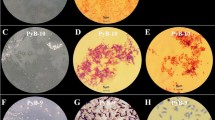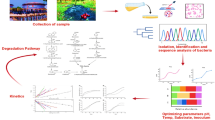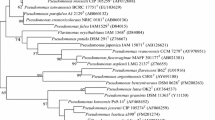Abstract
A novel phenanthrene (PHE)-degrading strain Massilia sp. WF1, isolated from PAH-contaminated soil, was capable of degrading PHE by using it as the sole carbon source and energy in a range of pH (5.0–8.0), temperatures (20–35 °C), and PHE concentrations (25–400 mg L−1). Massilia sp. WF1 exhibited highly effective PHE-degrading ability that completely degraded 100 mg L−1 of PHE over 2 days at optimal conditions (pH 6.0, 28 °C). The kinetics of PHE biodegradation by Massilia sp. WF1 was well represented by the Gompertz model. Results indicated that PHE biodegradation was inhibited by the supplied lactic acid but was promoted by the supplied carbon sources of glucose, citric acid, and succinic acid. Salicylic acid (SALA) and phthalic acid (PHTA) were not utilized by Massilia sp. WF1 and had no obvious effect on PHE biodegradation. Only two metabolites, 1-hydroxy-2-naphthoic acid (1H2N) and PHTA, were identified in PHE biodegradation process. Quantitatively, nearly 27.7 % of PHE was converted to 1H2N and 30.3 % of 1H2N was further metabolized to PHTA. However, the PHTA pathway was broken and the SALA pathway was ruled out in PHE biodegradation process by Massilia sp. WF1.






Similar content being viewed by others
References
Acuña ME, Pérez F, Auria R, Revah S (1999) Microbiological and kinetic aspects of a biofilter for the removal of toluene from waste gases. Biotechnol Bioeng 63:175–184
Bochner BR (1989) Sleuthing out bacterial identities. Nature 339:157–158
Bodour AA, Wang JM, Brusseau ML, Maier RM (2003) Temporal change in culturable phenanthrene degraders in response to long-term exposure to phenanthrene in a soil column system. Environ Microbiol 5:888–895
Bojes HK, Pope PG (2007) Characterization of EPA’s 16 priority pollutant polycyclic aromatic hydrocarbons (PAHs) in tank bottom solids and associated contaminated soils at oil exploration and production sites in Texas. Regul Toxicol Pharmacol 47:288–295
Deveryshetty J, Phale PS (2010) Biodegradation of phenanthrene by Alcaligenes sp. strain PPH: partial purification and characterization of 1-hydroxy-2-naphthoic acid hydroxylase. FEMS Microbiol Lett 311:93–101
Du Y, Yu X, Wang GJ (2012) Massilia tieshanensis sp. nov., isolated from mining soil. Int J Syst Evol Microbiol 62:2356–2362
Evans WC, Fernley HN, Griffith E (1965) Oxidative metabolism of phenanthrene and anthracene by soil Pseudomonads—ring-fission mechanism. Biochem J 95:819–831
Feng TC, Cui CZ, Dong F, Feng YY, Liu YD, Yang XM (2012) Phenanthrene biodegradation by halophilic Martelella sp. AD-3. J Appl Microbiol 89:67–73
Gallego V, Sánchez-Porro C, García MT, Ventosa A (2006) Massilia aurea sp. nov., isolated from drinking water. Int J Syst Evol Microbiol 56:2449–2453
Gao SM, Seo JS, Wang J, Keum YS, Li JQ, Li QX (2013) Multiple degradation pathways of phenanthrene by Stenotrophomonas maltophilia C6. Int Biodeterior Biodegrad 79:98–104
Gerhardt P, Murray R, Wood WA, Krieg NR (1994) Methods for general and molecular bacteriology. American Society for Microbiology, Books division, Washington, DC
Gu HP, Luo XY, Wang HZ, Wu LS, Wu JJ, Xu JM (2015) The characteristics of phenanthrene biosorption by chemically modified biomass of Phanerochaete chrysosporium. Environ Sci Pollut Res 22:11850–11861
Guo S, Fan R, Li T, Hartog N, Li F, Yang X (2014) Synergistic effects of bioremediation and electrokinetics in the remediation of petroleum-contaminated soil. Chemosphere 109:226–233
Han ZX, Meng Z, Lv CX (2011) Effect factors of biodegradation on phenanthrene by Pseudomonas putida. Adv Mater Res 396–398:2107–2110
Haritash A, Kaushik C (2009) Biodegradation aspects of polycyclic aromatic hydrocarbons (PAHs): a review. J Hazard Mater 169:1–15
Kämpfer P, Falsen E, Busse HJ (2008) Naxibacter varians sp. nov. and Naxibacter haematophilus sp. nov., and emended description of the genus Naxibacter. Int J Syst Evol Microbiol 58:1680–1684
Kim J (2014) Massilia kyonggiensis sp. nov., isolated from forest soil in Korea. J Microbiol 52:378–383
Lee DS, Lee MW, Woo SH, Park JM (2005) Effects of salicylate and glucose on biodegradation of phenanthrene by Burkholderia cepacia PM07. J Microbiol Biotechnol 15:859–865
Macías-Flores A, Tafoya-Garnica A, Ruiz-Ordaz N, Salmerón-Alcocer A, Juárez-Ramírez C, Ahuatzi-Chacón D, Mondragon-Parada ME, Galindez-Mayer J (2009) Atrazine biodegradation by a bacterial community immobilized in two types of packed-bed biofilm reactors. World J Microbiol Biotechnol 25:2195–2204
Mallick S, Chatterjee S, Dutta TK (2007) A novel degradation pathway in the assimilation of phenanthrene by Staphylococcus sp. strain PN/Y via meta-cleavage of 2-hydroxyl-1naphthoic acid: formation of trans-2, 3-dioxo-5-(2’-hydroxyphenyl)-pent-4-enoic acid. Microbiology 153:2104–2115
Masakorala K, Yao J, Cai MM, Chandankere R, Yuan HY, Chen HL (2013) Isolation and characterization of a novel phenanthrene (PHE) degrading strain Psuedomonas sp. USTB-RU from petroleum contaminated soil. J Hazard Mater 263:493–500
Moscoso F, Teijiz I, Deive FJ, Sanroman MA (2012) Efficient PAHs biodegradation by a bacterial consortium at flask and bioreactor scale. Bioresour Technol 119:270–276
Rosenberg M (1989) Bacterial adherence to hydrocarbons: a useful technique for studying cell surface hydrophobicity. FEMS Microbiol Lett 22:289–295
Saitou N, Nei M (1987) The neighbor-joining method: a new method for reconstructing phylogenetic trees. Mol Biol Evol 4:406–425
Seo JS, Keum YS, Hu YT, Lee SE, Li QX (2006) Phenanthrene degradation in Arthrobacter sp. P1-1: initial 1,2-, 3,4- and 9,10-dioxygenation, and meta- and ortho-cleavages of naphthalene-1,2-diol after its formation from naphthalene-1,2-dicarboxylic acid and hydroxyl naphthoic acids. Chemosphere 65:2388–2394
Seo JS, Keum YS, Li QX (2012) Mycobacterium aromativorans JS19b1T degrades phenanthrene through C-1,2, C-3,4 and C-9,10 dioxygenation pathways. Int Biodeterior Biodegrad 70:96–103
Shen L, Liu YQ, Wang NL, Yao TD, Jiao NZ, Liu HC, Zhou YG, Xu BQ, Liu XB (2013) Massilia yuzhufengensis sp. nov., isolated from an ice core. Int J Syst Evol Microbiol 63:1285–1290
Stackebrandt E, Goodfellow M (1991) Nucleic acid techniques in bacterial systematics. Wiley, Chichester
Tamura K, Peterson D, Peterson N, Stecher G, Nei M, Kumar S (2011) MEGA5: molecular evolutionary genetics analysis using maximum likelihood, evolutionary distance, and maximum parsimony methods. Mol Biol Evol 28:2731–2739
Vacca D, Bleam W, Hickey W (2005) Isolation of soil bacteria adapted to degrade humic acid-sorbed phenanthrene. Appl Environ Microbiol 71:3797–3805
van Herwijnen R, Joffe B, Ryngaert A, Hausner M, Springael D, Govers HAJ, Wuertz S, Parsons JR (2006) Effect of bioaugmentation and supplementary carbon sources on degradation of polycyclic aromatic hydrocarbons by a soil-derived culture. FEMS Microbiol Ecol 55:122–135
Weon HY, Kim BY, Son JA, Jang HB, Hong SK, Go SJ, Kwon SW (2008) Massilia aerilata sp. nov., isolated from an air sample. Int J Syst Evol Microbiol 58:1422–1425
Weon HY, Kim BY, Hong SK, Jeon YA, Koo BS, Kwon SW, Stackebrandt E (2009) Massilia niabensis sp. nov. and Massilia niastensis sp. nov., isolated from air samples. Int J Syst Evol Microbiol 59:1656–1660
Yamamoto S, Harayama S (1995) PCR amplification and direct sequencing of gyrB genes with universal primers and their application to the detection and taxonomic analysis of Pseudomonas putida strains. Appl Environ Microbiol 61:1104–1109
Zafra G, Absalón AE, Cuevas MDC, Cortés-Espinosa DV (2014) Isolation and selection of a highly tolerant microbial consortium with potential for PAH biodegradation from heavy crude oil-contaminated soils. Water Air Soil Pollut 225:1826–1843
Zhang J, Cornelia MN, Wang M, Cao Z, Luo X, Wong M, Chen W (2013) Change of PAHs with evolution of paddy soils from prehistoric to present over the last six millennia in the Yangtze River Delta region, China. Sci Total Environ 449:328–335
Acknowledgments
This work was supported by the National Natural Science Foundation of China (41471254, 41090284) and the Fundamental Research Funds for the Central Universities.
Author information
Authors and Affiliations
Corresponding author
Ethics declarations
Conflict of interest
The authors declare that they have no conflict of interest.
Additional information
Responsible editor: Robert Duran
Jun Lou, Haiping Gu and Xiaoyan Luo contributed equally to this work.
Rights and permissions
About this article
Cite this article
Wang, H., Lou, J., Gu, H. et al. Efficient biodegradation of phenanthrene by a novel strain Massilia sp. WF1 isolated from a PAH-contaminated soil. Environ Sci Pollut Res 23, 13378–13388 (2016). https://doi.org/10.1007/s11356-016-6515-6
Received:
Accepted:
Published:
Issue Date:
DOI: https://doi.org/10.1007/s11356-016-6515-6




